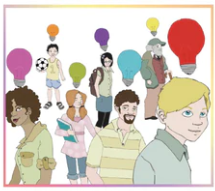
“My Brain” by Matthew Purdy, licensed via CC BY 4.0 . Flickr.
In A Private Universe, Heather, a 9th grade student, is formulating her understanding of the movement of the sun, Earth, and moon and how this creates the various seasons and the phases of the moon. Heather has a mixture of correct and incorrect understandings based on her prior knowledge, experience, and her formulated logic. Depending on Heather’s concepts she must either make small refinements (assimilations) of her current understanding to adapt to new or expanded information, or must discard former paradigms and adopt new ideas and structures (accommodations). Heather knows that the seasons are related to the Earth’s tilted axis as it revolves around the sun, despite her initially incorrect, but later resolved, understanding of the shape of the Earth’s orbit.
More challenging for her to resolve is her confusion about what is meant by direct and indirect solar rays on the Earth’s surface and their resulting effect. Heather is confused by the vocabulary, and even with the visual illustration demonstrating the difference she continues to think that the language is differentiating between non-reflected and reflected light rays. Although her end conclusions about the seasons based on the Earth’s orbit are correct, the underlying rationale is not. Her understanding of the phases of the moon, as a result of the moon’s position relative to the sun and Earth, is more cohesive, and although she indicates some confusion about the difference between a new moon and a lunar eclipse, through logical rationalization she correctly concludes that the lunar eclipse is due to the Earth’s shadow on the moon.
In the field of mathematical education, Booth et al. (2014) outline six types of mathematical errors in “Persistent and Pernicious Errors in Algebraic Problem Solving” that most typically occur. While some errors are quite predictable in their presence and typically resolve with continued practice in different contexts, other errors are indicative of more critical misconceptions and warrant intentional targeting in instruction and intervention. Specific strategies using manipulative tools are recommended to develop and reinforce key concept development. For example, negative number concepts align with the use of number lines and set models, equality concepts benefit from using balance scales and Geogebra (Ko & Keradag, 2012), and variable errors can be addressed with area tiles. Knowing what types of errors are to be expected allows teachers to anticipate and plan accordingly, through additional and varied activities or extra time and opportunity for student learning.

“Learner Ideation”, Image Credit: E. Warren
It is clear that teachers cannot assume that learners arrive in their classrooms with accurate understandings from earlier grades or even recent lessons. Rather, “students enter instruction with firmly held beliefs and explanations for phenomena and relationships, and these beliefs are subject matter specific and can be identified and confirmed only through methods that encourage children to be expressive and predictive” (Confey, 1990, p. 4). Learning is a process that involves rational activity and requires opportunities for students to question, test, discuss, and defend their ideas (Posner, 1982; Fosnot, 2013). Intentional and constructive cognitive conflict is an important and effective instructional strategy that elicits the required cognitive disequilibrium that serves as the fertile mental ground for students to work through the re-organization process of new conceptual paradigms (Fosnot, 2013; Cobb, 2005; von Glaserfeld, 2005). Digital tools can serve to provide necessary visualizations and manipulation to explore, clarify, and generate new concepts.
References
Annenberg Learner. (n.d.). A private universe [Video]. https://www.learner.org/series/a-private-universe/1-a-private-universe/
Booth, J., Barbieri, C., Eyer, F., & Pare-Blagoev, E.J. (2014). Persistent and pernicious errors in algebraic problem solving. The Journal of Problem Solving, 7(1), 10-23. https://doi.org/10.7771/1932-6246.1161
Cobb, P., (2005). Chapter 3: Where is the mind? A coordination of sociocultural ad cognitive constructivist perspectives. In C. T. Fosnot (Ed.), Constructivism: Theory, perspectives, and practice, (2nd ed., pp. 39-57). Teachers College Press.
Confrey, J. (1990). A review of the research on student conceptions in mathematics, science, and programming. Review of research in education, (16)1, 3-56. https://doi.org/10.3102/0091732X016001
Fosnot, C. & Perry, R. S. (2013). Chapter 2: Constructivism: A Psychological theory of learning. In C. T. Fosnot (Ed.), Constructivism: Theory, perspectives, and practice, (2nd ed., pp. 8-38). Teachers College Press.
Ko, W., & Karadag, Z. (2013). Fostering middle school students’ relational thinking of the equal sign using GeoGebra. Mevlana International Journal of Education, 3(3). 45-49. DOI: 10.13054/mije.si.2013.05.
Posner, G. J., Strike, K. A., Hewson, P. W. and Gertzog, W. A. (1982). Accommodation of a scientific conception: Toward a theory of conceptual change. Sci. Ed., 66: 211–227. doi: 10.1002/sce.373066020.
Von Glaserfeld, E. (2005). Introduction: Aspects of constructivism. In C. T. Fosnot (Ed.), Constructivism: Theory, perspectives, and practice (2nd ed., pp, 3-7). Teachers College Press.
